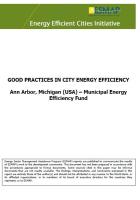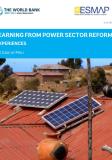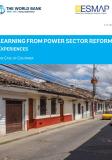Publications

With the establishment of a long-term Municipal Energy Efficiency Fund, the City of Ann Arbor was able to overcome the lack of readily available energy efficiency (EE) financing and to demonstrate that municipal governments can play a leadership role in showcasing the value and benefit of EE to its citizens and communities. Savings estimates for projects completed in 10 years (1998-2008) demonstrate that these projects have cumulatively resulted in almost US$0.86 million in energy cost reductions, 10.7 GWh in energy savings, and approximately 8,000 tonnes of CO2e. These projects have also improved the comfort and appearance of city facilities.
In 1988, Ann Arbor issued a US$1.4 million bond to finance various EE projects and retrofits at 30 city facilities. Savings from subprojects supported under the bond convinced the city to sustain its support for EE financing. Thus, once the bond was repaid in 1998, the city chose to retain the annual budget line item for bond repayment (but reduced it by 50 percent to about US$100,000 each year) for five years to create the initial US$500,000 capital for a municipal EE revolving fund. The Fund provides upfront capital for municipal EE projects, which is difficult for budget entities to mobilize on their own, and then collects 80 percent of the resulting energy cost savings for a period of five years. The Fund does not guarantee savings, but bases its repayments on estimates. This model of payment from savings has helped to motivate facility managers to move forward with the projects while becoming a self-sustaining mechanism (i.e., no additional appropriations are required).
The Fund has financed EE projects in several sectors, including light emitting diode (LED) traffic and pedestrian lights, street light improvements, parking garage lighting, a building-level boiler, two electric vehicles, and rooftop photovoltaic (PV) cells. More importantly, the Fund also demonstrates that EE can pay for itself in the long term. Success stories from projects funded through the Fund are used to create public awareness and motivate citizens and other organizations to adopt EE into their planning and programs. The Fund has been a low-cost mechanism which has been relatively simple to implement, but has yielded substantial impacts which have generated interest from other U.S. cities and municipalities around the world.
ESMAP. 2011. Good Practices in City Energy Efficiency: Ann Arbor, Michigan (USA) - Municipal Energy Efficiency Fund. ESMAP Energy Efficient Cities Initiative. Washington, DC: World Bank.


